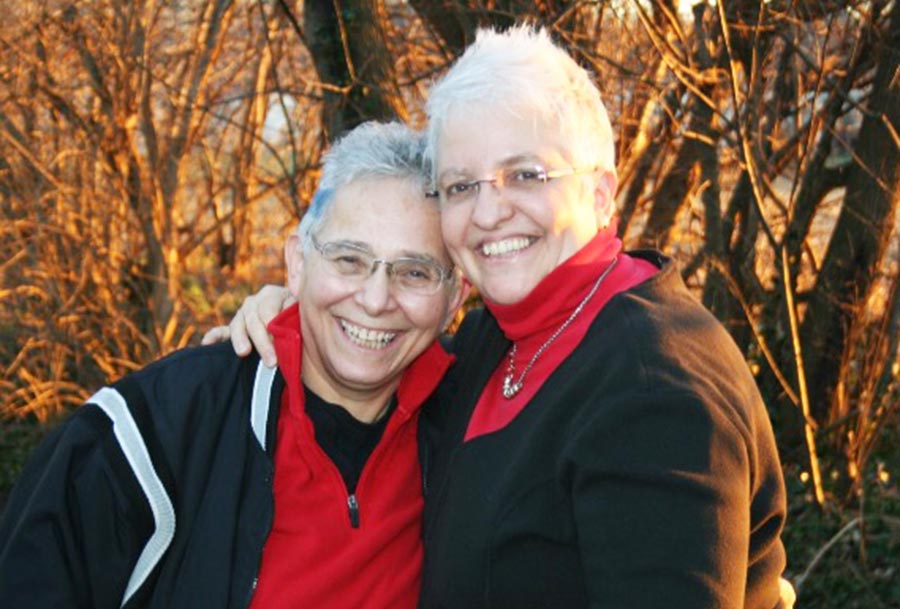The last Christmas gift Sam Morse wanted was a pink tree. Because the Philadelphia native was so beloved, she got one from her spouse, Eileen Schaller, and another from her doctor.
“On her sick bed, she had two identical pink Barbie Christmas trees,” said Colleen O’Connell, a friend of Morse for more than a decade. “Sam was butch. But she had a glamorous side that she kept somewhat hidden.”
Morse died Jan. 4 at the age of 69 from complications related to cancer in her spine, liver and lungs.
“Sam thought she would get radiation on her spine until the pain went away, then chemotherapy on the rest,” O’Connell said. “But the pain never went away. The first thing we knew was wrong with her was a backache on Thanksgiving.”
Morse had recently retired from the Philadelphia Redevelopment Authority, where she worked as a supervising inspector. She spent the majority of her career advocating for affordable housing with organizations like the Kensington Community Development Corporation and Philadelphia Neighborhood Housing Services. She earned a Platinum Award from the federal Department of Housing and Urban Development for designing the plans to turn a vacant property in Fern Rock into affordable housing.
Morse also advocated for the LGBT community. She attended the July 4, 1965, march outside Independence Hall, known as Annual Reminder Days, to protest for gay rights. But, because Morse was a hippie in the ’60s, she almost didn’t get to march; the protesters instructed men to wear blazers and women to wear dresses so the public would take them seriously.
O’Connell shared the details of a story that Morse told frequently to her friends: A group of hippies went to the march and sat in a circle on a nearby lawn. The group waited until nearly the end of the protest, to allow the traditionally dressed people their time, before joining the action themselves. Morse said she got the chance to meet famed activist Barbara Gittings. She recounted her experience on a Sept. 21 broadcast of the radio show “Outsources,” which is available here: www.kgnu.org/outsources.
Morse spent her youth on South Street and ultimately made a home in Roxborough with Schaller. The couple met in 1998 on a blind date that was set up by a contractor friend of Morse. Schaller said when she spotted Morse wearing an old, beat-up pair of sneakers to their first date, she was smitten.
“We immediately had a connection,” she said. “We talked for hours. We shared the same principles, yet we were opposite each other in many ways with our skills.”
Morse could dive in and fix anything, while Schaller was more of an organizer.
“When we worked together, we covered all the bases,” Schaller said. “We had a lot of fun. She always woke up happy, enthusiastic and ready to go.”
They built a life together over nearly 18 years. A rabbi married them in 2001 and they had what they called their “paperwork ceremony” in 2014. Morse arranged for the wedding party to perform the wedding march on kazoos.
“When we had our reception, she started giving away the remaining wine,” Schaller said. “I seek to emulate her open-handed generosity.”
Morse was a big believer in the Jewish value of tikkun olam, which stipulates active contributions to make the world a better place. Schaller, who grew up Catholic, said she and Morse weren’t religious, but spiritual.
O’Connell said when she attended Passover Seder at the couple’s home, Morse would read from a feminist Haggadah that highlighted brave Jewish women, their accomplishments and sacrifices.
Morse and Schaller liked to host parties with home-cooked meals. They also took frequent vacations with their friends, including O’Connell and her spouse Connie Youkon. O’Connell remembered one time in the 1980s at a department store in Cape Cod when she and Morse went shopping for gold lamé slippers.
“We ended up laughing so hard and carrying on that they asked us to leave,” O’Connell said. “I can imagine that store manager didn’t know quite what to make of us.”
“She was really herself,” Schaller added, “always herself.”
Morse was a great conversationalist and a voracious reader, O’Connell said. Morse also painted and gave her work to friends. O’Connell keeps one piece hanging in her house: It has a deep blue background with a girl in the middle. Abstract flowers behind the girl float into the horizon and appear to turn into birds along the way.
Morse was buried in a Jewish ceremony at Weinstein Mortuary in Hartford, Conn., where her mother is from. She lies next to her parents. Donations in her honor can be made to the American Jewish Joint Distribution Committee, General Israel Orphan’s Home for Girls in Jerusalem, the Environmental Defense Fund or Jewish Family and Children’s Services of Greater Philadelphia.
